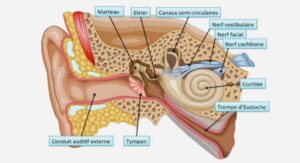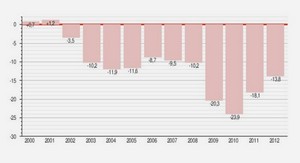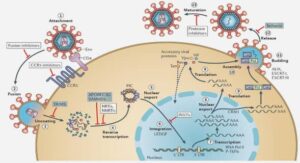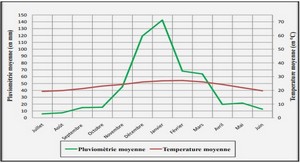USING MULTIMEDIA TO IMPROVE LYCÉE LEARNERS’ PRONUNCIATION
THEORETICAL CONSIDERATIONS
Pronunciation refers to the phonology of the language – or the meaningful perception and production of the sounds of that language and how they impact on the listener2 . Pronunciation involves two main features: The segmental (micro) level which concerns the production of the sounds (consonants and vowel sounds), and the suprasegmental (macro) level which refers to the features above the segments (Stress, rhythm, intonation and linking). This first part of the present dissertation will mainly focus on the explanation in details of the essential aspects of English pronunciation and on the materials which will be exploited for their teaching.
OVERVIEW OF THE ENGLISH PRONUNCIATION
Mechanisms of sound production and articulatory classification of speech sounds
The Speech organs Speech organs are body structures that work together so that people can communicate through spoken language3 . In order to make a clear description of the English sound production, it is necessary to have elementary knowledge of the structure of the organs of speech and of the way they work. The Figure n°1 shows the sagittale structure of human‘s vocal tract. Figure n°01: The organs of speech ( ROACH, Peter: 1998) The larynx The larynx, also known as the voice box is a small structure formed of cartilage and muscle situated in the upper part of the trachea. The voice box contains the vocal folds (usually known as the vocal cords) which are two elastic membranes set horizontally from the front to the back. They can assume different position to shape speech sounds: They can be wide opened so that an air flow from the lungs can passes through without obstruction, the sounds consequently produced are called ―voiceless4 ‖ or ―breathed‖ sounds. Also, they can be held together and vibrate to form ―voiced‖ sounds. The Pharynx The pharynx is a tube which begins just above the larynx. It measures about 7 cm long in women and 8 cm in men; at its top end, it is divided into two: One part being the back of the mouth and the other being the beginning of the way through the nasal cavity. The velum Otherwise called soft palate, the velum is the lower part of the roof of the mouth. It could be lowered or raised to give airflow from the lung access to go through nasal cavity or not. The hard palate The hard palate is the concave part of the roof of the mouth. It is located in the middle part of the roof of the mouth. The alveolar ridge/tooth ridge The alveolar ridge is situated between the top front teeth and the hard palate. Its shape can be felt with the tongue. Sounds which are made with touching this convex part are called alveolar. The tongue The tongue is a very essential organ and is responsible for the production of many speech sounds since it can move into many different places and different shapes. It is common to consider the tongue into four parts: the tip, which is the extreme end of the tongue; the blade, the part of the tongue which lies opposite to the alveolar ridge; the front which lies 4 English sounds which have those features will be dealt with further in this chapter. 6 opposite to the hard palate; and the back, refers to the part which is opposite to the soft palate. The teeth (lower and upper) The teeth are also very helpful in producing speech sounds. The sounds which are made with the tongue touching the teeth are called dental. The lips The lips also play major roles in sounds production. They can be pressed together, brought into contact with the teeth, or rounded to produce the lip shape necessary to the target sounds to be produced. All sounds that human beings make when speaking are the result of the following steps. The lungs provide a flow of air that is needed for the production and emission of sounds. Then, the vocal folds situated in the larynx produce different modifications in the air stream. After passing through the larynx, the air-stream undergoes further modifications according to the shape assumed by the upper cavities of the pharynx and mouth and according to whether the nasal cavity is brought into use or not. All the sounds, which production is accompanied by a closure or narrowing in the vocal tract which would prevent the escape of the air stream through the mouth or give rise to audible friction are called ―consonants‖; all other sounds are called ―vowel‖
Production of English consonant sounds: place and manner of articulation
Three main points are to be taken into consideration in the description of the way how consonant sounds are produced. First, the place of articulation which refers to the organs of speech involved in the production of a particular sound. Then, the manner of articulation which refers to the way the sound is produced and the way the airstream is modified as it passes through the vocal tract. Finally, the voicing, refers to whether the vocal folds are vibrating during the production of a particular sound when the air stream passes through the larynx or not. The following chart summarizes the list of English consonants As it can be seen in the table, every English consonant sound can be described in term of place of articulation, manner of articulation, and voicing.
PLACE OF ARTICULATION
The classification of consonants according to the organs which are involved when producing them permits to distinguish the following: Bilabial articulation: the two lips articulate together to create an obstruction to the air-flow. English language bilabial sounds include /p/, /b/, and /m/. Labio-dental articulation: The lower lip articulates with the upper teeth. They are /f/ and /v/ sounds. Dental articulation: sounds are articulated by the tip of the tongue and the upper teeth; for example, the /ð/ and /I/ sounds. Alveolar articulation: the blade or tip and blade of the tongue articulate with the alveolar ridge. The English sounds which have this feature include /t/, /d/, /l/, /n/, /s/ and /z/. Post-alveolar articulation: includes consonant sounds which are articulated with the tongue near or touching the back of the alveolar ridge, such as the /ʃ/, /tʃ/, /ʒ/ and /ʤ/ sounds. Palatal articulation: The front of the tongue is raised against the hard palate. For English sound, the palatal sound includes /j/ Velar articulation: Velar sounds are pronounced with the back of the tongue touching the soft palate. They include /k /, /g/ and /E/ sounds. Glottal articulation: a friction is made in the larynx. There is an obstruction, or a narrowing causing friction, between the vocal cords. This phenomenon happens during the production of the /h/ sound.
MANNER OF ARTICULATION
In term of manner, the distinction depends on the degree of obstruction made by the organs. In fact, the obstruction might be total, intermittent, partial, or may merely constitute a narrowing enough to cause friction. The English consonants ‗manner of articulation consists of: Stop or plosive: They are called ―stop‖ because the airflow is stopped at some point in the vocal tract, or ―plosive‖ because it is subsequently released explosively. They are /p/, /b/, /t/, /k/ and /g
GENERAL INTRODUCTION |



